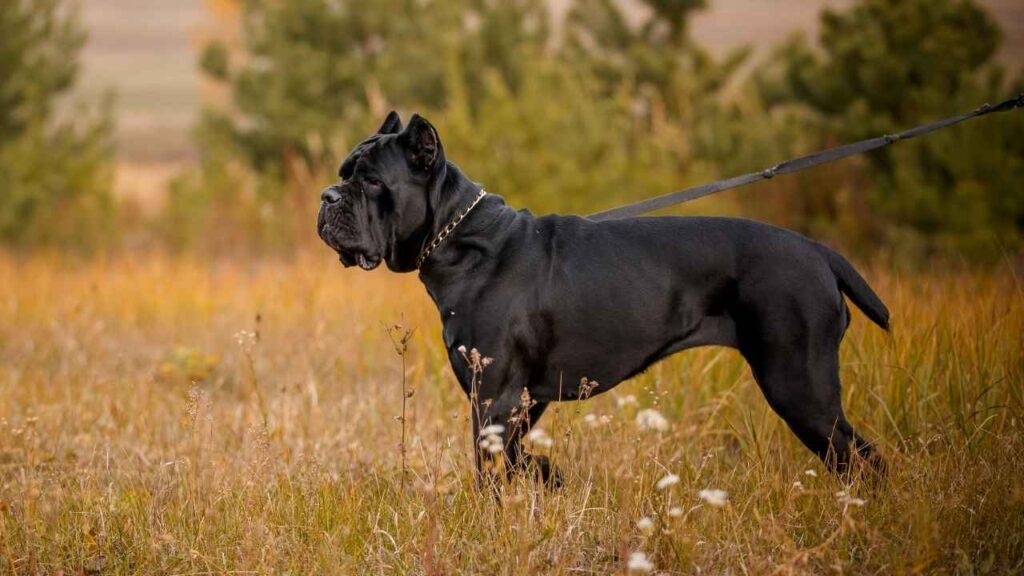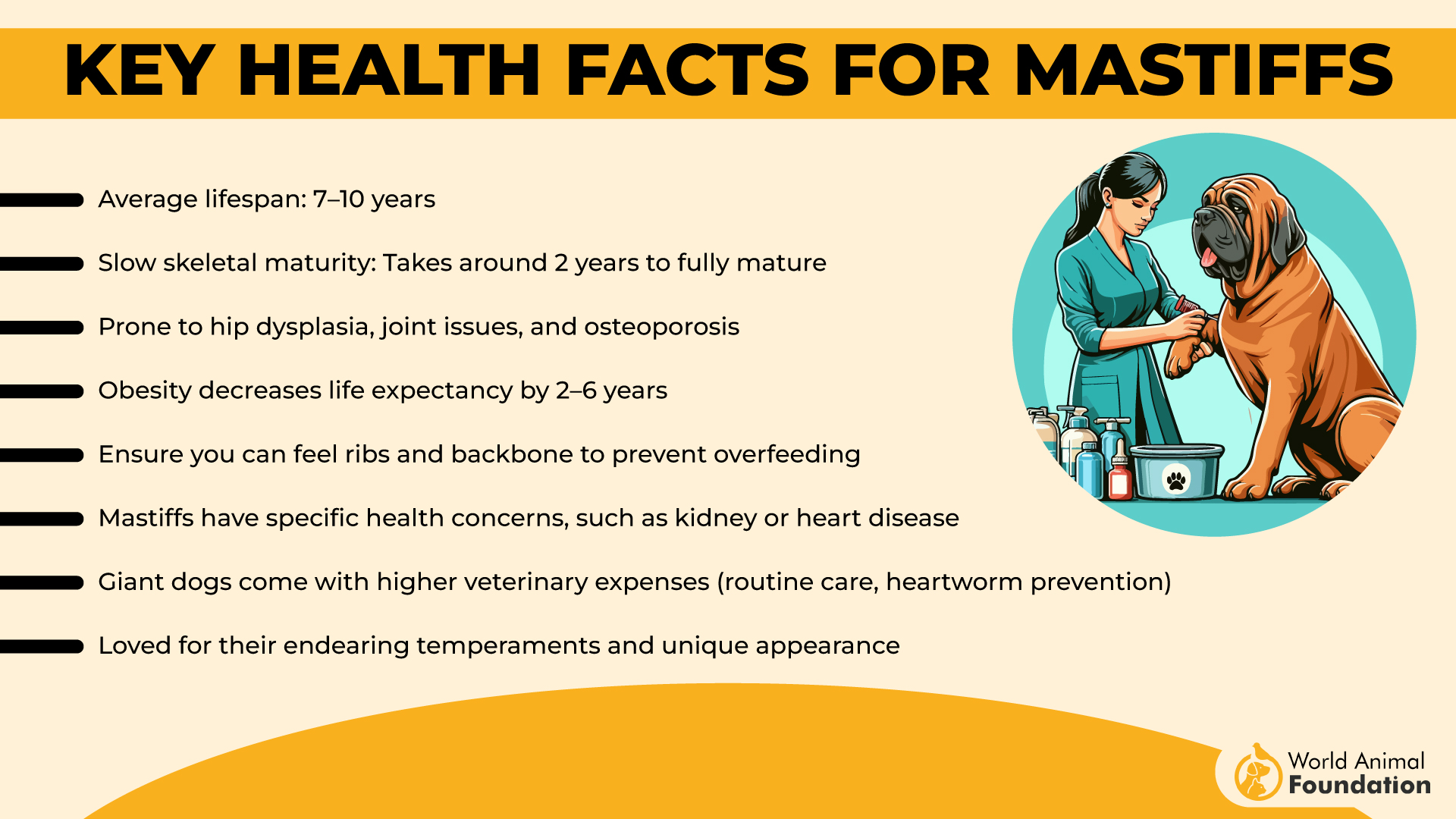The Cane Corso and Neapolitan Mastiff may share ancient Roman war dog ancestry, but they’ve evolved into two very different guardians. The Cane Corso is a lean, muscular protector—smart, trainable, and always ready for action. In contrast, the Neapolitan Mastiff is an intimidating giant, relying on sheer bulk, sagging wrinkles, and a serious case of don’t-mess-with-me energy to deter intruders.
The Cane Corso thrives on training, enjoys working with its owner, and has the stamina for intense activity. Meanwhile, the Neapolitan Mastiff prefers a more laid-back, silent guardian role, observing from a distance rather than chasing threats. Both breeds are deeply loyal, but their different exercise, training, and grooming needs make them better suited for different owners.
Choosing between these breeds depends on whether you want a highly trainable, athletic protector or a massive, low-energy deterrent. Let’s dive into the key differences!
Cane Corso vs. Neapolitan Mastiff
Feature |
Cane Corso |
Neapolitan Mastiff |
|---|---|---|
|
Temperament |
Intelligent, trainable |
Calm, independent |
|
Size |
Large, muscular |
Massive, heavy-boned |
|
Energy |
High, needs exercise |
Low, prefers rest |
|
Trainability |
Easy to train |
Stubborn, slower learner |
|
Grooming |
Low, short coat |
High, loose skin care |
|
Health |
Generally healthy |
Prone to dental disease, skin issues |
|
Lifespan |
9–12 years |
7–9 years |
|
Family |
Great family pets |
Protective, less social |
|
Other Pets |
Can adjust with training |
Wary, not ideal |
|
Best For |
Active, engaged owners |
Experienced handlers |
Cane Corso vs. Neapolitan Mastiff: Temperament
According to the AKC, the Cane Corso is a confident, alert, and highly trainable working dog. It thrives on structure and commands, making it an excellent choice for owners who want a responsive and obedient guardian.
While protective, it is deeply loyal and forms strong bonds with its family, balancing its guarding instincts with affection and playfulness. Proper socialization ensures it remains stable and well-mannered around other pets and strangers.

The Neapolitan Mastiff is more reserved and independent. Bred for guarding, it has a natural wariness toward strangers and does not require extensive training to develop its protective instincts.
Unlike the energetic Cane Corso, the Neapolitan Mastiff is more laid-back but still highly territorial. It can be aloof, preferring to observe rather than actively engage with unfamiliar people or animals.
The Cane Corso is more adaptable and responsive between these breeds, while the Neapolitan Mastiff is a more imposing, low-energy guardian. Those looking for a trainable, interactive protector will find the Cane Corso more engaging, whereas the Neapolitan Mastiff is best suited for owners who appreciate a quiet, powerful presence.
Cane Corso vs. Neapolitan Mastiff: Training and Behavior
The Cane Corso is one of the most trainable mastiff breeds, excelling in obedience, protection work, and canine sports. Its intelligence and eagerness to please make it highly responsive to structured training. It requires firm but fair leadership, as a lack of guidance can lead to stubbornness and dominance issues. Early socialization is key to ensuring it is well-behaved around people and other dogs.
The Neapolitan Mastiff, in contrast, is more independent and less inclined toward structured obedience training. While intelligent, it is not as eager to follow commands and tends to do things on its own terms.
Training requires patience and consistency, but owners should not expect the same level of responsiveness as with a Cane Corso. Neapolitan Mastiffs are naturally protective and do not require extensive guard dog training, but they must be socialized early to prevent aggression.

For novice owners, the Cane Corso is the easier breed to manage due to its trainability. The Neapolitan Mastiff, with its strong-willed nature and sheer size, is better suited for experienced handlers who understand mastiff behavior.
Cane Corso vs. Neapolitan Mastiff: Health and Care
Both breeds are prone to joint issues, particularly hip and elbow dysplasia, due to their size and weight. The Cane Corso is a more active breed and requires regular exercise to maintain muscle strength and prevent obesity. They are also prone to heart conditions and bloat, requiring careful diet management and portion control.
The Neapolitan Mastiff has more health concerns due to its excessive skin folds and heavy build. As per PetMD, it is prone to skin infections, heart disease, eye issues, and joint problems from an early age.
Its large, drooping eyes are susceptible to cherry eye and entropion, conditions that may require surgical correction. Like the Cane Corso, it is also at risk for bloat, making meal monitoring crucial.
Both breeds need regular vet checkups, but the Neapolitan Mastiff generally requires more attention due to its skin and eye issues. Those looking for a lower-maintenance guardian in terms of health care will find the Cane Corso a slightly easier breed to manage.

Cane Corso vs. Neapolitan Mastiff: Grooming and Maintenance
The Cane Corso has a short, dense coat that sheds moderately throughout the year. It requires weekly brushing to remove loose hair and keep its coat looking healthy. Its grooming routine is relatively simple, with occasional nail trimming, ear cleaning, and dental care.
The Neapolitan Mastiff, on the other hand, has significantly higher grooming needs, says PetMD. Its loose, wrinkled skin must be cleaned regularly to prevent bacterial infections.

Dirt and moisture can accumulate in its deep folds, leading to irritation and unpleasant odors if not properly maintained. Additionally, it drools excessively, requiring frequent face cleaning.
While both breeds have short coats, the Neapolitan Mastiff’s wrinkles and drooling add a layer of grooming responsibility. Owners who prefer a lower-maintenance breed will find the Cane Corso easier to care for, while the Neapolitan Mastiff requires dedicated upkeep.
Cane Corso vs. Neapolitan Mastiff: Life Expectancy
Like most large dog breeds, the Cane Corso and Neapolitan Mastiff have short lifespans. The Cane Corso typically lives between 9 to 12 years, benefiting from its athleticism and slightly lighter frame. With a balanced diet, regular exercise, and proper medical care, some individuals can reach the upper end of this range.
The Neapolitan Mastiff has a shorter lifespan, averaging 7 to 9 years. Its massive size and genetic health conditions contribute to its reduced longevity. Joint problems, heart disease, and skin infections are common issues that can impact its overall health and comfort in later years.

For those seeking a breed with a longer lifespan and greater activity levels, the Cane Corso has a slight advantage. The Neapolitan Mastiff, while a formidable and loyal protector, requires owners who are prepared for a shorter time commitment due to its health challenges.
Breed |
Lifespan |
Common Health Issues |
|---|---|---|
|
Cane Corso |
9–12 years |
Hip dysplasia, heart disease, bloat |
|
Neapolitan Mastiff |
7–9 years |
Hip dysplasia, skin infections, eye issues, bloat |
Conclusion
The Cane Corso and Neapolitan Mastiff are majestic breeds, but their roles differ. The Cane Corso is extremely intelligent, trainable, and thrives on structured work. At the same time, with its loose skin and imposing size, the Neapolitan Mastiff is a laid-back guardian that intimidates without much effort. Both are large dogs with immense bite force, making them excellent protectors.
Health-wise, they are generally healthy, but both need monitoring for dental disease and joint issues. The Cane Corso’s gray brindle coat is low-maintenance, while the Neapolitan Mastiff’s wrinkles require extra care.
Though they can be great family pets, their protective nature means early socialization is key for coexisting with other animals. Like a Pit Bull, they need proper training to balance their power with stability. Supporting their physical and mental health ensures they are not just guardians but also loyal, well-adjusted companions.


